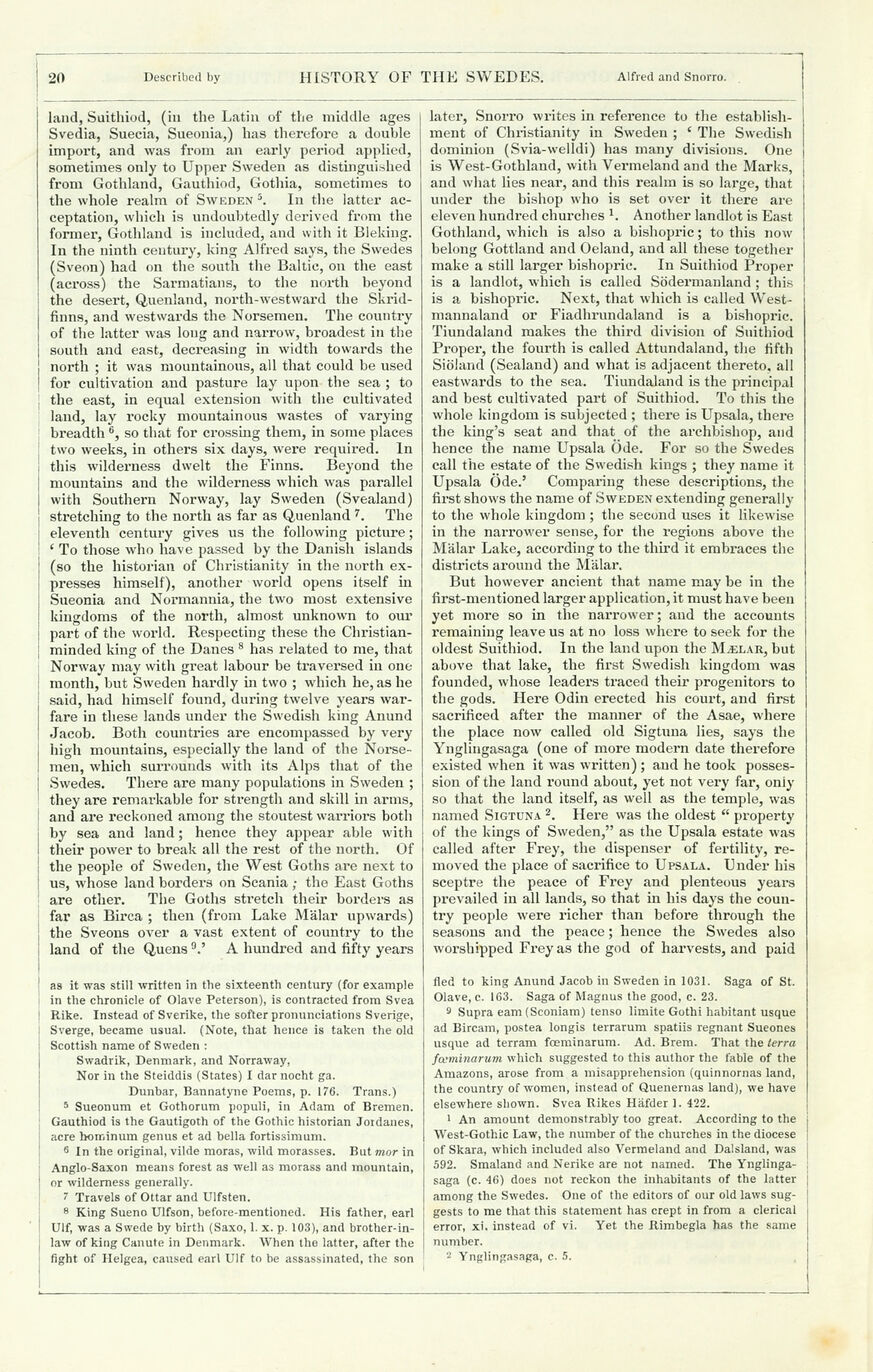
Full resolution (JPEG) - On this page / på denna sida - II. Land and People from the Heathen Period

<< prev. page << föreg. sida << >> nästa sida >> next page >>
Below is the raw OCR text
from the above scanned image.
Do you see an error? Proofread the page now!
Här nedan syns maskintolkade texten från faksimilbilden ovan.
Ser du något fel? Korrekturläs sidan nu!
This page has been proofread at least once.
(diff)
(history)
Denna sida har korrekturlästs minst en gång.
(skillnad)
(historik)
Swedeland, Suithiod, (in the Latin of the middle ages
Svedia, Suecia, Sueonia,) has therefore a double
import, and was from an early period applied,
sometimes only to Upper Sweden as distinguished
from Gothland, Gauthiod, Gothia, sometimes to
the whole realm of Sweden [1]. In the latter
acceptation, which is undoubtedly derived from the
former, Gothland is included, and with it Bleking.
In the ninth century, king Alfred says, the Swedes
(Sveon) had on the south the Baltic, on the east
(across) the Sarmatians, to the north beyond
the desert, Quenland, north-westward the
Skridfinns, and westwards the Norsemen. The country
of the latter was long and narrow, broadest in the
south and east, decreasing in width towards the
north; it was mountainous, all that could be used
for cultivation and pasture lay upon the sea; to
the east, in equal extension with the cultivated
land, lay rocky mountainous wastes of varying
breadth [2], so that for crossing them, in some places
two weeks, in others six days, were required. In
this wilderness dwelt the Finns. Beyond the
mountains and the wilderness which was parallel
with Southern Norway, lay Sweden (Svealand)
stretching to the north as far as Quenland [3]. The
eleventh century gives us the following picture;
‘To those who have passed by the Danish islands
(so the historian of Christianity in the north
expresses himself), another world opens itself in
Sueonia and Normannia, the two most extensive
kingdoms of the north, almost unknown to our
part of the world. Respecting these the
Christian-minded king of the Danes [4] has related to me, that
Norway may with great labour be traversed in one
month, but Sweden hardly in two; which he, as he
said, had himself found, during twelve years
warfare in these lands under the Swedish king Anund
Jacob. Both countries are encompassed by very
high mountains, especially the land of the
Norsemen, which surrounds with its Alps that of the
Swedes. There are many populations in Sweden;
they are remarkable for strength and skill in arms,
and are reckoned among the stoutest warriors both
by sea and land; hence they appear able with
their power to break all the rest of the north. Of
the people of Sweden, the West Goths are next to
us, whose land borders on Scania; the East Goths
are other. The Goths stretch their borders as
far as Birca; then (from Lake Mälar upwards)
the Sveons over a vast extent of country to the
land of the Querns [5].’ A hundred and fifty years
later, Snorro writes in reference to the establishment
of Christianity in Sweden; ‘The Swedish
dominion (Svia-welldi) has many divisions. One
is West-Gothland, with Vermeland and the Marks,
and what lies near, and this realm is so large, that
under the bishop who is set over it there are
eleven hundred churches [6]. Another landlot is East
Gothland, which is also a bishopric; to this now
belong Gottland and Oeland, and all these together
make a still larger bishopric. In Suithiod Proper
is a landlot, which is called Södermanland; this
is a bishopric. Next, that which is called
Westmannaland or Fiadhrundaland is a bishopric.
Tiundaland makes the third division of Suithiod
Proper, the fourth is called Attundaland, the fifth
Siöland (Sealand) and what is adjacent thereto, all
eastwards to the sea. Tiundaland is the principal
and best cultivated part of Suithiod. To this the
whole kingdom is subjected; there is Upsala, there
the king’s seat and that of the archbishop, and
hence the name Upsala Öde. For so the Swedes
call the estate of the Swedish kings; they name it
Upsala Öde.’ Comparing these descriptions, the
first shows the name of Sweden extending generally
to the whole kingdom; the second uses it likewise
in the narrower sense, for the regions above the
Mälar Lake, according to the third it embraces the
districts around the Mälar.
But however ancient that name may be in the
first-mentioned larger application, it must have been
yet more so in the narrower; and the accounts
remaining leave us at no loss where to seek for the
oldest Suithiod. In the land upon the Mælar, but
above that lake, the first Swedish kingdom was
founded, whose leaders traced their progenitors to
the gods. Here Odin erected his court, and first
sacrificed after the manner of the Asae, where
the place now called old Sigtuna lies, says the
Ynglingasaga (one of more modern date therefore
existed when it was written); and he took
possession of the land round about, yet not very far, only
so that the land itself, as well as the temple, was
named Sigtuna [7]. Here was the oldest “property
of the kings of Sweden,” as the Upsala estate was
called after Frey, the dispenser of fertility,
removed the place of sacrifice to Upsala. Under his
sceptre the peace of Frey and plenteous years
prevailed in all lands, so that in his days the
country people were richer than before through the
seasons and the peace; hence the Swedes also
worshipped Frey as the god of harvests, and paid
<< prev. page << föreg. sida << >> nästa sida >> next page >>